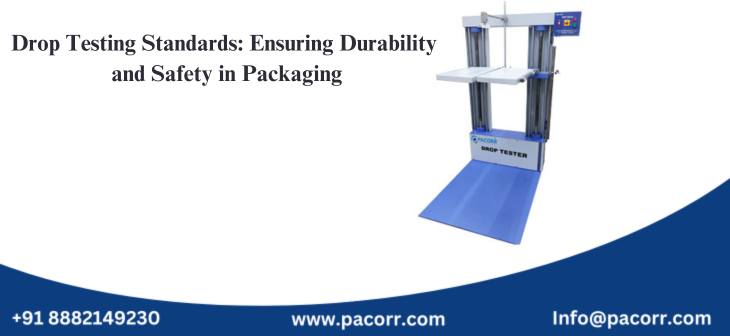
Drop testing is a critical step in ensuring that a product and its packaging can withstand the rigors of handling and transportation. Whether it involves fragile electronics, robust industrial tools, or delicate medical devices, drop testing provides assurance that products remain intact and functional during transit. Standardized guidelines, such as ISO 2248, ASTM D5276, ASTM D4169, MIL-STD-810G 516.6, IEC 60601-1, and ASTM D7386, establish reliable protocols for evaluating packaging performance under simulated real-world conditions.
These standards serve as benchmarks for businesses that prioritize quality and safety. Pacorr, a trusted provider of testing instruments, offers solutions that enable industries to comply with these standards, ensuring product durability and customer satisfaction.
ISO 2248: Packaging – Complete, Filled Transport Package – Vertical Impact Test
The ISO 2248 standard is designed to evaluate how a package resists vertical impacts during handling and shipping. This method simulates accidental drops or impacts that occur during manual or mechanical handling.
Features of ISO 2248:
- Objective: The goal is to measure a package’s ability to protect its contents when subjected to vertical shock.
- Test Process: A package is dropped from a specified height onto a hard surface, and its structural integrity is assessed.
- Use Case: This standard is highly relevant for products in industries such as consumer electronics and industrial tools, where packaging integrity is crucial.
Compliance with ISO 2248 helps businesses minimize the risk of product damage, reducing return rates and ensuring a positive customer experience.
ASTM D5276: Standard Test Method for Drop Testing of Loaded Containers by Free Fall
ASTM D5276 outlines a straightforward process for evaluating how well a loaded container withstands drops from varying heights. It is one of the most widely used methods in packaging to assess resilience against accidental falls.
Key Highlights:
- Scope: The method applies to different types of containers, such as corrugated boxes, plastic packaging, and metal enclosures.
- Procedure: The container is dropped from a pre-determined height onto a hard surface, and the damage, if any, is carefully analyzed.
- Application: This standard is essential for transportation and logistics, ensuring that goods remain undamaged throughout their supply chain journey.
Businesses can use ASTM D5276 to identify weaknesses in their packaging design, allowing for improvements that enhance product safety.
ASTM D4169: Performance Testing of Shipping Containers and Systems
The ASTM D4169 standard goes beyond individual drop testing to simulate the complete transportation environment. It provides a comprehensive evaluation of a shipping container’s ability to endure a range of potential hazards.
Key Features:
- Simulated Conditions: The testing process includes vibrations, compression, shock, and even environmental conditions like temperature fluctuations or humidity.
- Drop Test Role: Drop testing is a vital element of this broader standard, focusing on the potential impacts during loading and unloading.
- Industries: The standard is widely adopted by e-commerce, manufacturing, and logistics sectors.
By following ASTM D4169, businesses ensure their shipping systems perform optimally, even under challenging conditions.
MIL-STD-810G 516.6: Military Standard for Drop Testing
The MIL-STD-810G 516.6 standard, developed for military applications, sets rigorous testing criteria for equipment durability under extreme conditions. Although initially created for military use, it is now used in various industries, including aerospace and consumer electronics.
Key Aspects:
- Extreme Testing: This standard simulates harsh conditions, including repeated drops, temperature extremes, and rugged terrains.
- Drop Testing: The focus is on ensuring that equipment can endure impacts from different angles and heights.
- Broader Application: Many manufacturers use MIL-STD-810G 516.6 to validate their products for reliability in harsh environments.
By adhering to this standard, businesses can demonstrate their commitment to durability and quality, earning customer trust.
IEC 60601-1: Medical Equipment Safety Standard
The IEC 60601-1 standard addresses safety and performance requirements for medical electrical equipment. Drop testing forms an essential part of this standard, as medical devices must remain operational and safe even after accidental drops.
Key Elements:
- Primary Objective: The standard ensures that medical equipment can withstand mechanical shocks without compromising functionality or patient safety.
- Testing Process: Devices are dropped from specific heights to simulate accidental handling incidents in hospitals or homes.
- Applications: It applies to products such as ventilators, infusion pumps, and diagnostic tools.
Compliance with IEC 60601-1 is a vital step for manufacturers seeking certification for medical devices. Pacorr provides testing instruments designed to meet these stringent requirements, helping businesses achieve global standards of excellence.
ASTM D7386: Performance Testing for Single Parcel Delivery Systems
With the growth of e-commerce, the ASTM D7386 standard has become increasingly important. It evaluates the ability of packaging to endure the challenges of single-parcel delivery systems, where packages are often dropped, thrown, or mishandled.
Key Features:
- Simulation: The test replicates conditions experienced during individual parcel deliveries, such as impacts, vibrations, and rough handling.
- Drop Test Focus: Packages are dropped multiple times from various heights and angles to determine their resilience.
- Industry Relevance: Online retailers and courier services benefit significantly from this standard, ensuring that goods reach customers in pristine condition.
By following ASTM D7386, businesses can reduce complaints and returns due to damaged goods, enhancing overall customer satisfaction.
Why Drop Testing Standards Matter
Adopting drop testing standards is essential for businesses that prioritize quality and reliability. These standards help identify potential vulnerabilities in packaging design and product durability, providing opportunities for improvement. The benefits of compliance include:
- Enhanced Safety: Ensures that products are protected during transit, reducing the likelihood of damage.
- Cost Efficiency: Minimizes financial losses caused by returns and replacements.
- Regulatory Compliance: Meets international quality standards, enabling products to compete in global markets.
- Customer Trust: Demonstrates a commitment to delivering reliable and durable goods.
Pacorr, as a provider of high-quality testing instruments, empowers manufacturers to perform accurate and reliable drop tests, ensuring compliance with these essential standards.
Drop testing is a crucial component of quality control, offering manufacturers the assurance that their products and packaging can endure the challenges of real-world handling and transportation. Standards like ISO 2248, ASTM D5276, ASTM D4169, MIL-STD-810G 516.6, IEC 60601-1, and ASTM D7386 provide a framework for consistency and reliability. By following these guidelines and utilizing advanced testing equipment from trusted providers like Pacorr, businesses can safeguard their products, enhance customer satisfaction, and build a reputation for quality.
Thanks to Pacorr Testing instruments, we have all the required quality testing instruments that have helped us to ensure the best quality delivered to our clients.

Danish
Fair Exports Pvt. Ltd.

